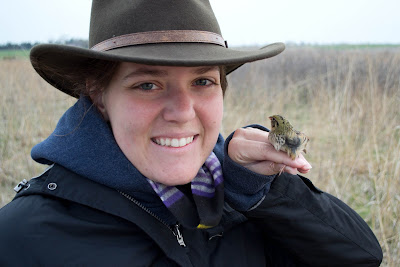I have officially been in Missouri for one week now, though I've only been working since Monday. Work started out kind of slow because the birds we're studying (Henslow's Sparrows) hadn't migrated here yet. So for the first couple of days we wandered around our study sites and tried to catch and band as many birds as we could so that Keith (the other tech) and I could start learning how to band. Levi (my boss) also drove us around some of the random back roads to see what was around. Unfortunately I forgot my camera on the first day of work, so I missed pictures of the Bald Eagle nest, the Pileated woodpecker and the Northern Shrike. But I know where the first two live, so I will be going back for pictures.
 |
| Robins are everywhere up here. |
 |
| Okay, so it's not a real bird, but we're right by and airforce base so we see these "birds" a lot. |
 |
| An American Kestrel we caught hanging out on a power line while driving home. |
 |
| Red-winged blackbirds are also everywhere. This guy is trying to get some tail. |
For the first 3 days that we worked we couldn't find one single Henslow's Sparrow. Instead we caught savannah sparrows (6 flew into the net all at once), field sparrows and grasshopper sparrows. To most people these guys all look alike, little brown birds with chirpy calls. But they're pretty different; grasshopper sparrows are the closest looking to Henslow's but their call sounds almost exactly like a grasshopper. Field sparrows sound like somebody dropped a ping-pong ball and it's bouncing across the floor. Savannah sparrows are pretty quiet, but they stay in groups of 3-10 most of the time, while other sparrows fly in ones and twos. Finally, on Thursday Levi heard our first Henslow. Their call is pretty short, but they throw their head back and open their little beak up like they're belting out an opera. We spotted the little guy with our scope and set our mist nets up in a basket shape. Slowly the three of us crept out and around him, while he kept singing. Then we ran (oddly, running across a tall-grass prairie is a lot easier than walking) and chased him into the net with shouts of triumph.
 |
| Levi with the first Henslow's Sparrow of the season. |
 |
| When I held him he decided to show his backside to the camera. |
 |
| He was more cooperative for Keith's picture. |
 |
| This is how we sex the birds and determine how much fat stores they have. |
 |
| They don't really like us much by the time we finish getting our data. |
 |
| So we let them fly off to continue singing. |
 |
| Our feistiest Sparrow kept biting everything, including his own wing when we let him go. |
 |
| This is a swamp sparrow, they're redder than Henslow's and prefer to live by creeks and ponds. |
 |
| This is what it looks like when a bird gets caught in a mist net. |
 |
| Very pale Savannah Sparrow staring into Levi's camera. |
 |
| Brown thrashers are mimics, this guy lived up to his name and thrashed enough in the net to lose a claw. |
 |
| He had a bit of an attitude, but so would I if I lost a toe to Aliens. |
 |
| If you lift the birds up while holding their feet they automatically get set to fly away. |
 |
| While being very pretty, Cardinals beaks are strong enough to draw blood, like this guy did. |
 |
| This is the main point of mist netting, banding the birds. |
|
Missouri has been pretty exciting so far, I've seen quite a few birds that I've never seen before (and will hopefully soon get pictures of). I plan on using some of my free time to go take more pictures of whatever wildlife I can find and I'll keep taking pictures of all the different birds we net. Soon some the migratory birds will be coming back and we might get an indigo or painted bunting or some other really cool birds. I'm also secretly hoping that we'll catch a short eared owl or another raptor in the net, but I doubt our little nets would survive and I wouldn't want to sew up the hole they'd punch in the net. It's bad enough having to sew up the holes that the smaller birds make.



















Interesting. What is he trying to find out about henslow? Just migratory patterns? Could you do a little project of your own while you're there? Some kind if paper or essay to send out? Maybe just a reflection on what you are going through. I could see it as an article for Orion, with your photos as well.
ReplyDeleteI'm not completely positive but I'm pretty sure that he's looking at the nesting habits of the Henslow's Sparrow. He's trying to determine whether they refer warm or cool season grasses and if they have a average buffer space between them and a different habitat (Woodland, roads, cropland etc). If he can find out what the preferred habitat requirements are as well as the territory size then he can help determine the best way to restore the grasslands so that habitable area is maximized
ReplyDelete